Free download: Top 10 Natural & Easy Remedies for Joint Pain from Home. Learn these helpful remedies.
Estimated Reading Time: 11 minutes read
Hyperextended Elbow Injury can be quite a challenge to recover from. Who knew such a small area could cause so much pain??
What exactly causes this injury of the elbow?…
Will the elbow joint heal on its own?…
What can I do to move along healing of the injured elbow?…
These are all great questions! We’ll be diving into the specifics of how the elbow joint can experience a hyperextension injury, as well as best exercises and tips to protect a hyperextended elbow.
Table of Contents
What is the Elbow Joint?
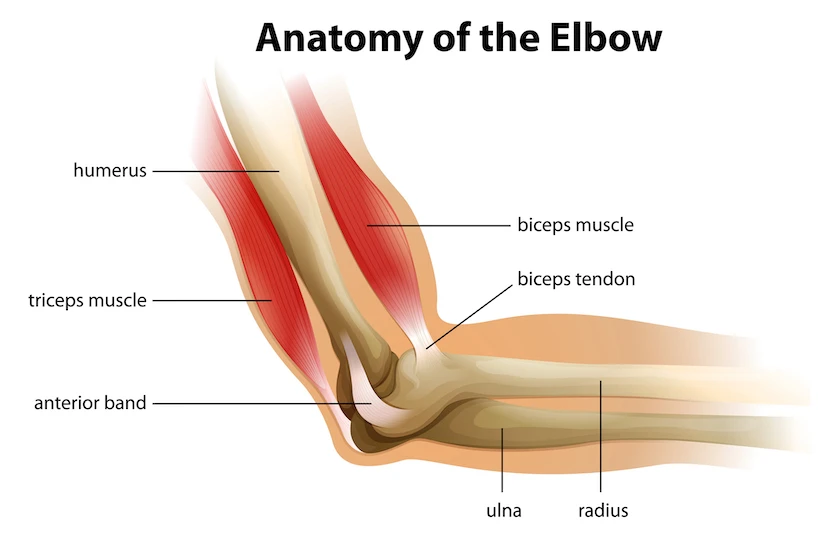
The elbow joint lies between the upper arm and forearm. The elbow is the meeting point and connection between the humeral bone, found in the upper arm, and the radial and ulnar bones, found in the forearm.
Now, these bones don’t all connect together to form one massive joint. There are actually three separate joint combinations and connections among these three bones that create what we know as the elbow and allow movements that come from the elbow. These joints include:
- Humeroulnar joint
- Humeroradial joint
- Proximal radioulnar joint (there’s also a distal radioulnar joint at the wrist, but we’ll save that for a later topic)
Movement among these joints allows for flexion, extension, pronation and supination at the elbow.
You need all of these motions in order to drink your morning cup of coffee, pick up your baby, lift weights in the gym, or offer a piece of gum to someone.
Surrounding where a joint connects are soft tissues that aid in support and stabilization of that joint. This mainly includes muscles, tendons and ligaments.
Elbow hyperextension can place excessive stress and strain on these soft tissues, leading to an injury of the elbow.
What Causes a Hyperextended Elbow?
A hyperextended elbow can occur from an injury, or someone may naturally have a hyperextended elbow.
A hyperextension injury most commonly occurs in sports and from a fall onto an outreached hand.
a. Sports or Athletic Injury
Certain sports, especially playing contact sports, create an increased risk for elbow hyperextension.
OrthoNeuro lists some of the most common sports examples for this type of injury to include football, gymnastics, and weightlifting.
b. Fall Injury
Many times, when we trip and fall, the most natural response is to reach with an outstretched arm to catch ourselves.
Unfortunately, this puts an extreme amount of stress on the elbow joint and surrounding soft tissues. This is a very common cause of a hyperextension injury.
These injuries can cause damage at the joint and/or soft tissue damage.
c. Naturally Hyperextended Elbow
Some of us are just truly blessed… our natural range of motion includes hyperextended elbows… lucky us!
This may be due to how you’re anatomically built, or your medical history could make you prone to have lax joints, making you more susceptible for a hyperextension injury.
While day-to-day this really isn’t a big deal, being naturally hyperextended can make you more prone to injury and developing chronic elbow instability.
If you participate in some of the types of sports or recreational activities listed above or experience a bad fall yourself… you’re at a much higher risk to be severely injured.
Signs and Symptoms of an Elbow Hyperextension Injury
Okay, so we know what the elbow joint consists of and what causes a hyperextended elbow… how do we know if we actually have experienced an elbow hyperextension injury?
There’s a pretty common consensus of signs and symptoms associated with elbow hyperextension injuries. The following will usually occur immediately at the time of injury:
- A popping sound
- Intense, instant sharp pain
- Rapid elbow swelling
- Elbow tenderness
- Possible elbow deformity
- Injured elbow stiffness
- Muscle weakness in the arm
- Muscle spasms
Mueller Sports Medicine concurs with these signs and symptoms, as well as the most common recommendations for managing this type of injury of the elbow.
Tips to Protect a Hyperextended Elbow
Let’s discuss how you can best protect a hyperextended elbow after an injury or if this is your natural anatomical structure.
Acute Phase of Injury
RICE! Any acute pain is best managed with the RICE method:
R: Rest:
To allow the injured arm to heal correctly, make sure to rest it properly. Avoid excessive use of the injured area and other vigorous physical activity.
I: Ice:
In order to ease swelling and pain, make sure to ice. You can use an ice pack or a cold compress.
Keep the ice applied for about 10-20 minutes at a time, giving yourself at least a 30-minute break between icing sessions. Don’t over-ice as this can negatively affect the injured tissues and circulation.
C: Compress:
Application of compression can also help to relieve swelling and pain. You can use an elastic bandage, such as an ACE wrap, or a special elbow brace.
- If using an elastic bandage, make sure it’s not applied too tightly (it shouldn’t feel like a tourniquet); otherwise, you may begin experience signs or symptoms that may include numbness or tingling in the arm, or discoloration due to poor circulation.
- If using an elbow brace, make sure it feels supportive of the elbow, but also does not feel too tight like mentioned with elastic bandage wrapping.
E: Elevate:
To further reduce pain and swelling, try to elevate the arm. You can keep it supported on a surface, such as a pillow. Aim to keep the injured arm elevated above the level of the heart.
The acute phase of injury is typically considered the first 3 days after it has occurred. During this phase is when you should apply the RICE method.
hyperextended elbow early rehab consideration
Once out of the initial acute phase, your medical doctor may have you undergo physical therapy or occupational therapy to address your current symptoms.
This may involve regaining normal range of motion, addressing elbow and arm strength, manual therapy to address stiffness related to swelling, and practicing proper form with exercise and activities.
Managing more severe symptoms
If, however, you experience elbow deformity or intense pain that is not responding to RICE, seek emergency medical services immediately.
You may require imaging, such as magnetic resonance imaging (MRI), to confirm bone and/or soft tissue injury. In more severe injuries, you may have to have the arm immobilized and/or surgical treatment may be required.
Chronic Elbow Hyperextension Management

If you’re naturally hyperextended or a previous hyperextension injury has made you develop chronic elbow instability, there are some exercises and tips while exercising to consider to best strengthen and stabilize around the elbow.
Similar to what was mentioned above for early rehab consideration, your medical doctor may also refer you to a physical therapist or occupational therapist in the chronic phase of management.
Even in the chronic phase, rehab will still address any range of motion restrictions, elbow and arm strength, manual therapy if you experience any acute flare ups of pain that may cause swelling, and correct form with exercise and functional activities.
General form tips during exercise and functional activities
- Prevent elbow hyperextension during exercise or activity, especially in a weight bearing position, such as a push-up or plank on the hands.
- If you feel instant pain with any exercise or activity, don’t continue.
- Keep a small bend at the elbow during upper body weight bearing activities as mentioned above, or if moving the arms away from the body or overhead, such as with forward/lateral raises or overhead presses.
Best Exercises for a Hyperextended Elbow
While there are many possible exercises to help strengthen and stabilize a hyperextended elbow, we’ll take a look at a few of the most basic, but effective exercises.
1. Bicep Curl
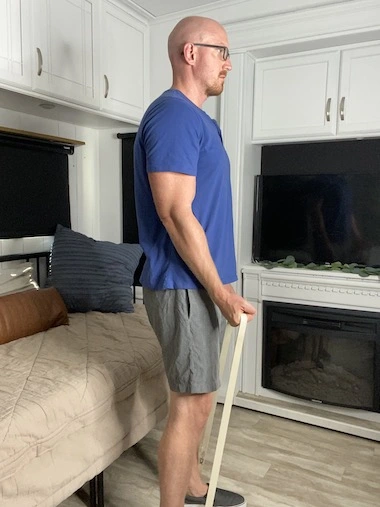
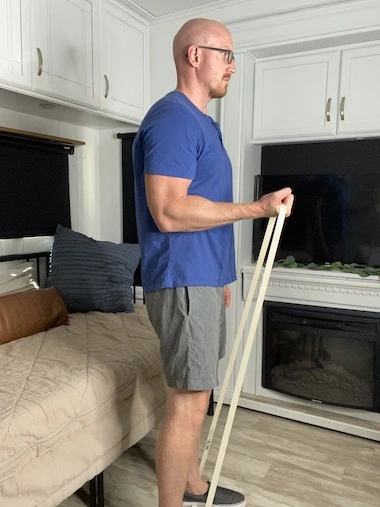
- Starting position: Either seated or standing with the arm by your side (avoid elbow hyperextended by keeping a small bend in the elbow); palm faces forward.
- Slowly bend the elbow. Your hand will be moving towards the shoulder.
- Once you’ve curled through your max range of motion, slowly return to your starting position.
- Make sure the upper arm stays secure by your side during the bicep curl.
- Repeat 10-15 repetitions for 2-3 sets. You can use free weights or a resistance band for a greater challenge.
2. Tricep Extension
There are a couple of options for the tricep extension: overhead or with the arm by your side.
a. Overhead
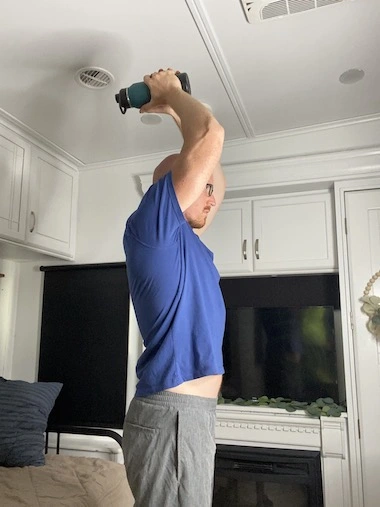
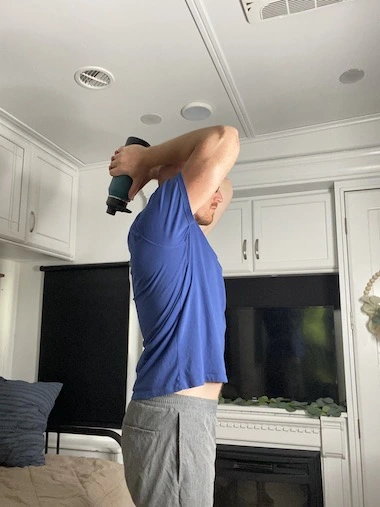
- Starting position: Holding a free weight (use a weight that you’re comfortable with) in one or both hands, raise the arms overhead with the elbow/s flexed.
- Slowly straighten the elbow/s as far as you can without locking out.
- Slowly return to your starting position.
- Repeat 10-15 repetitions for 2-3 sets. Modify the weight you’re using accordingly to avoid straining.
b. Arm By Your Side
If holding the arms in an overhead position is bothersome for the shoulders, consider the tricep extension with the arms by your side.
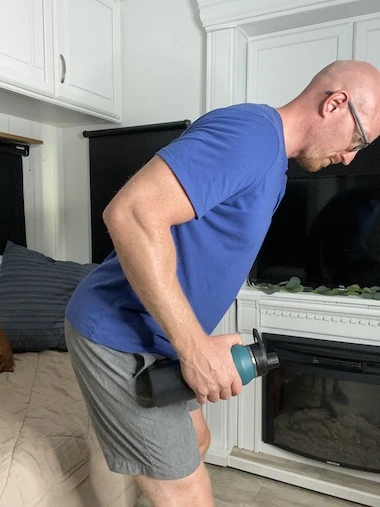
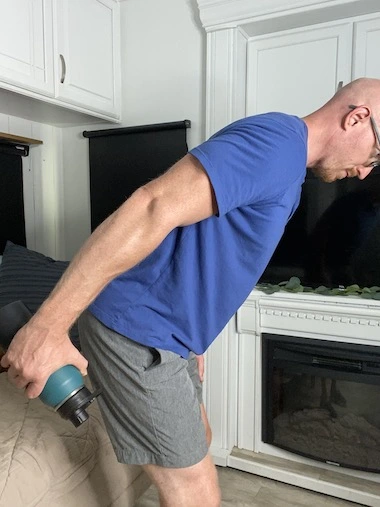
- Starting position: Begin in a small squat with the upper arms tucked at your side; elbows bent about 90 degrees. You can also use a free weight for this exercise.
- Slowly straighten the elbows (the hands will move behind you) as far as possible without locking or hyperextending.
- Slowly return to your starting position.
- Repeat 10-15 repetitions for 2-3 sets. Modify the weight you’re using accordingly.
You could also consider using a resistance band for the tricep extension; however, one hand will need to hold and stabilize the band, while the other performs the tricep extension.
3. Pronation

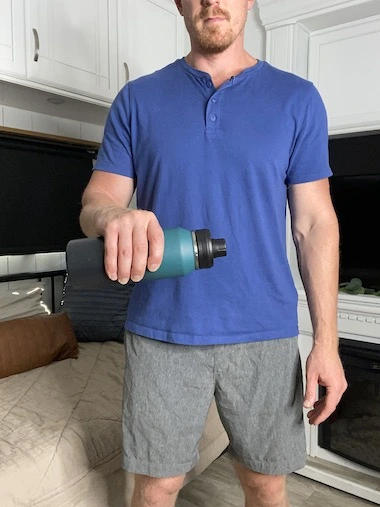
- Starting position: Arm by your side with the elbow flexed about 90 degrees. Thumb is pointed towards the ceiling.
- You can perform this seated or standing. You can use a light free weight or a resistance band with the opposite end of the band attached to something secure, such as a doorknob (make sure you’re positioned so that when you turn the forearm, you’ll be moving away from the resistance band).
- Slowly turn the forearm so that the palm faces down to the floor.
- The upper arm should remain still.
- Slowly return to your starting position.
- Repeat 10-15 repetitions for 2-3 sets. Modify the intensity of the free weight or resistance band as needed.
4. Supination
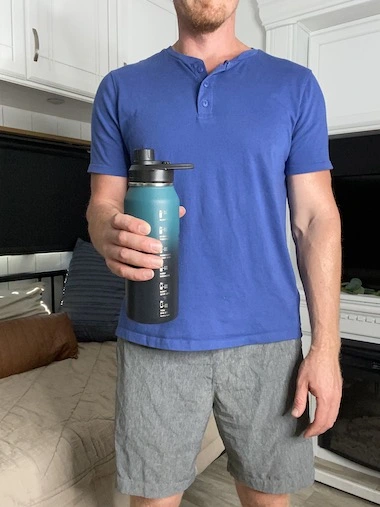
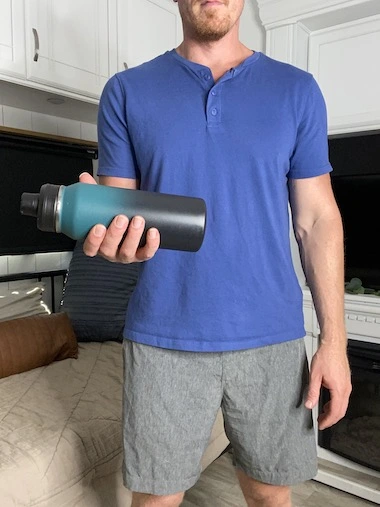
- Starting position: Similar to pronation, arm by your side with the elbow flexed about 90 degrees. Thumb is point towards the ceiling.
- You can perform this seated or standing. You can use a light free weight or a resistance band with the opposite end of the band attached to something secure, such as a doorknob (make sure you’re positioned so that when you turn the forearm, you’ll be moving away from the resistance band).
- Slowly turn the forearm so that the palm faces up to the ceiling.
- The upper arm should remain still.
- Slowly return to your starting position.
- Repeat 10-15 repetitions for 2-3 sets. Modify the intensity of the free weight or resistance band as needed.
Final Thoughts
A hyperextended elbow is very manageable. The cause of your elbow hyperextension largely determines how to approach treatment and management.
Hopefully you’ve found these recommended tips and exercises beneficial, but never forget to consult with your healthcare professional if you feel that you need a more in-depth assessment and guidance for further management of your symptoms.
FAQ:
If I need an elbow brace, what is the best one to get?
There are a lot of options for off the shelf elbow braces. Try a soft brace to allow support, yet also full motion at the elbow. Make sure that the fit is snug, but not so tight that it feels like a tourniquet.
How long should I wear an elbow brace for?
ou may need a brace in the earlier phases of healing, but once pain and swelling are managed, try to wean yourself away from using it regularly. You want to give your soft tissues a chance to re-learn how to support the joint on their own.
You can always consult with your medical doctor or rehab specialist for their recommendations as to when you should stop using a brace.
What do I do if my elbow is still hurting after doing the recommended exercises and tips?
If you’ve tried to manage a less severe injury on your own, but pain is persisting past the first 1-2 weeks after your injury or pain onset, consult with your medical doctor for a more in-depth assessment.
You may require imaging and a referral to physical or occupational therapy.

















One Response
I have a torn meniscus that was repaired so it’s not in great shape and now my hamstring is tight. I don’t know if I pulled some thing. I’ve been in physical therapy for three weeks. They said it takes a really long time. Any ideas I do use the rolling pin on my IT band.